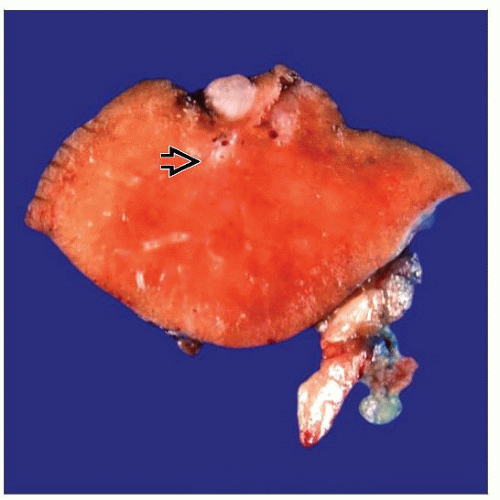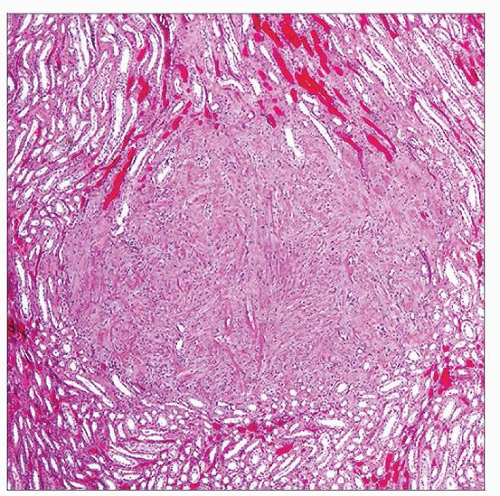Renomedullary Interstitial Cell Tumor
Satish K. Tickoo, MD
Victor E. Reuter, MD
Key Facts
Terminology
Benign renal medullary neoplasm, arising from renomedullary interstitial cells
Clinical Issues
Most common kidney tumor of adults
Most often, incidental finding in nephrectomies performed for other tumors or at autopsy
Incidence in autopsy series varies from 16-42%
Very rarely, tumor may compress pelvicalyceal system, leading to hydronephrosis and urosepsis
Macroscopic Features
Most measure < 5 mm in greatest dimension
Very occasional, much larger masses (≥ 5 cm) also reported
Microscopic Pathology
Densely collagenized tumors with sparse spindle cells
Keloid-like collagenous bands may be present in such tumors
Or variably cellular tumors usually with abundant spindle to stellate cells in myxoid stroma
Top Differential Diagnoses
Mixed epithelial and stromal tumor (MEST)
Usually larger mass lesion and primary reason for nephrectomy
Epithelial component in MEST distributed throughout tumor, and stroma in MEST usually ER and PR positive
TERMINOLOGY
Abbreviations
Renomedullary interstitial cell tumor (RMICT)
Synonyms
Medullary fibroma
Definitions
Benign renal medullary neoplasm, arising from renomedullary interstitial cells
ETIOLOGY/PATHOGENESIS
Renal Medullary Interstitial Cell
Renomedullary interstitial cells (RMIC) are located in inner renal medulla
These cells express receptors for multiple vasoactive peptides, including angiotensin II
RMIC plays important role in renin release and regulation of sodium excretion
These, in turn, maintain renal blood flow and normal blood pressure
RMIC tumors are believed by many to develop in response to systemic hypertension
Others have found no such relationship between these tumors and systemic hypertension
Recently, concomitant expression of COX-2, microsomal prostaglandin E synthase-1, and prostaglandin E2 (PGE2) receptor have been demonstrated in RMIC tumors
COX-2 activity is known to provide antiapoptotic protection of interstitial cells during osmotic stress
RMIC tumors show constitutive activation of COX-2
Results in increased PGE2 production and activation of PGE2 receptors
This activation is believed to act in autocrine manner, leading to tumoral proliferation of interstitial medullary cells
CLINICAL ISSUES
Epidemiology
Incidence
Most common kidney tumor of adults
Incidence in autopsy series is 16-42%
Incidence increases with age
Very rare tumors are described in young patients; youngest reported in a 14 year old
Incidence is also related to relative thoroughness of sampling of tissue
Presentation
Most often incidental finding in nephrectomies performed for other tumors or at autopsy
Rare association between multiple RMICTs and systemic hypertension has been reported
Very rarely, tumor may compress pelvicalyceal system, leading to hydronephrosis and urosepsis
Occasional incidental finding in needle biopsy of kidney has also been described
Prognosis
Benign tumors
MACROSCOPIC FEATURES
Stay updated, free articles. Join our Telegram channel

Full access? Get Clinical Tree





